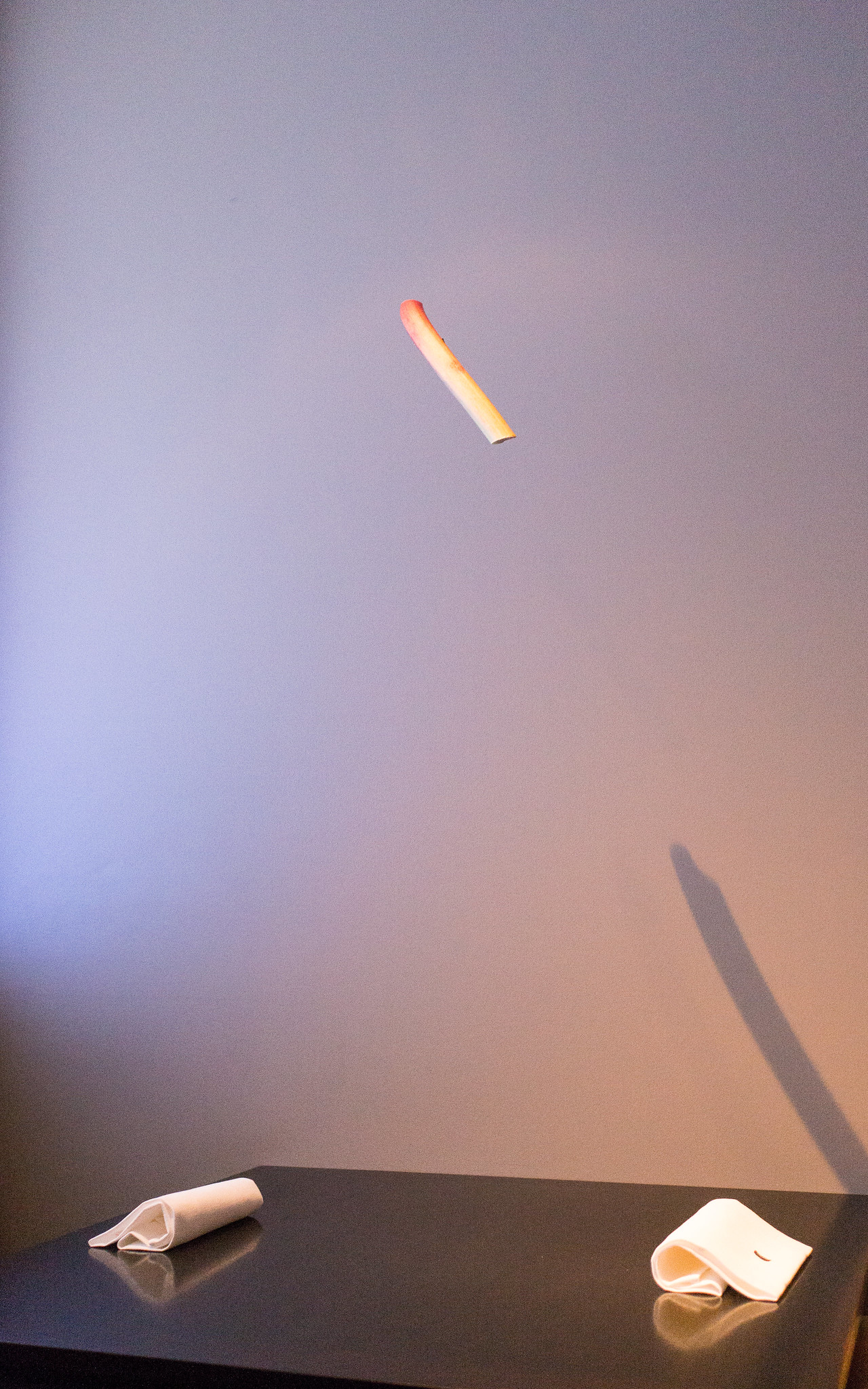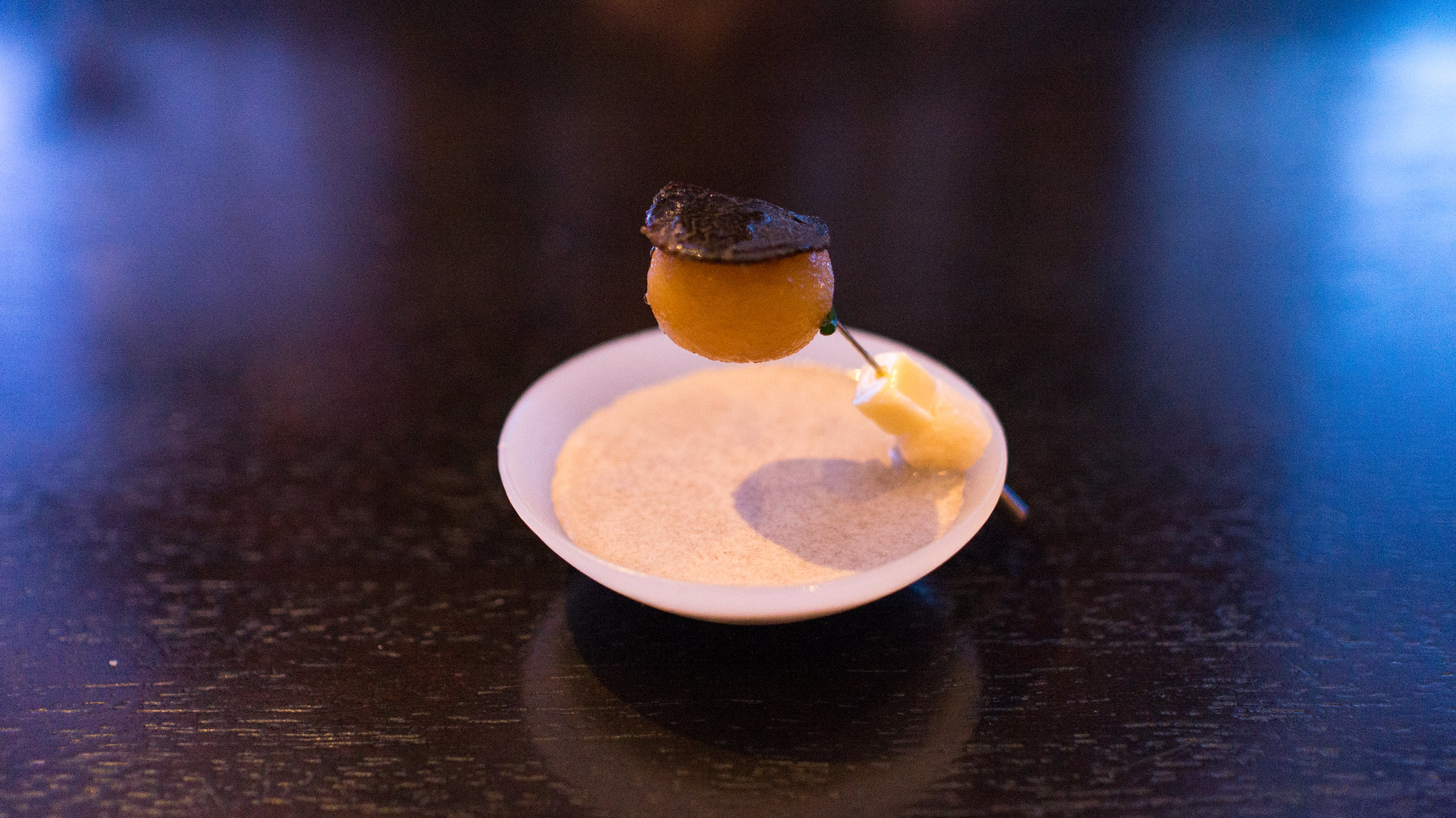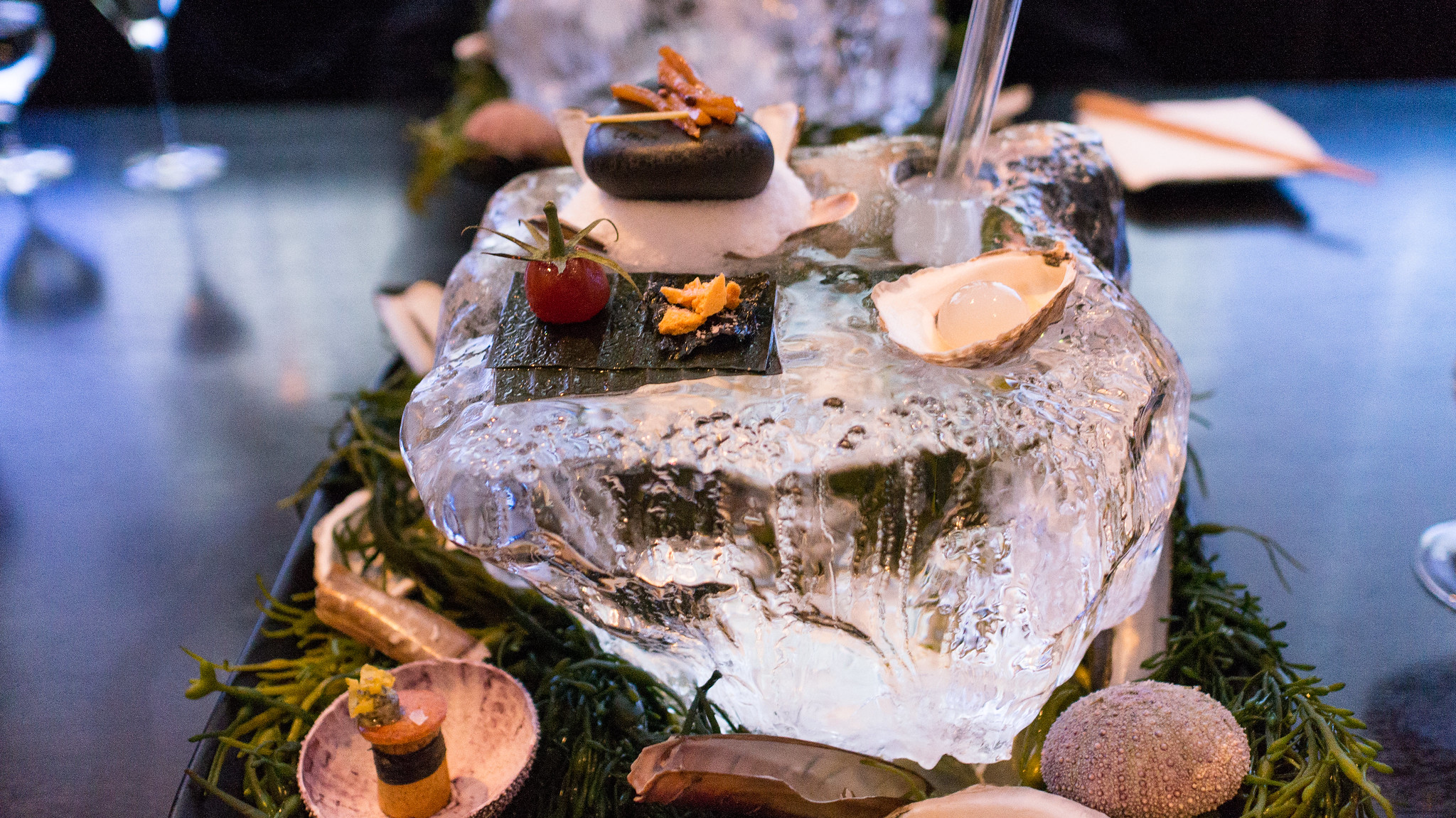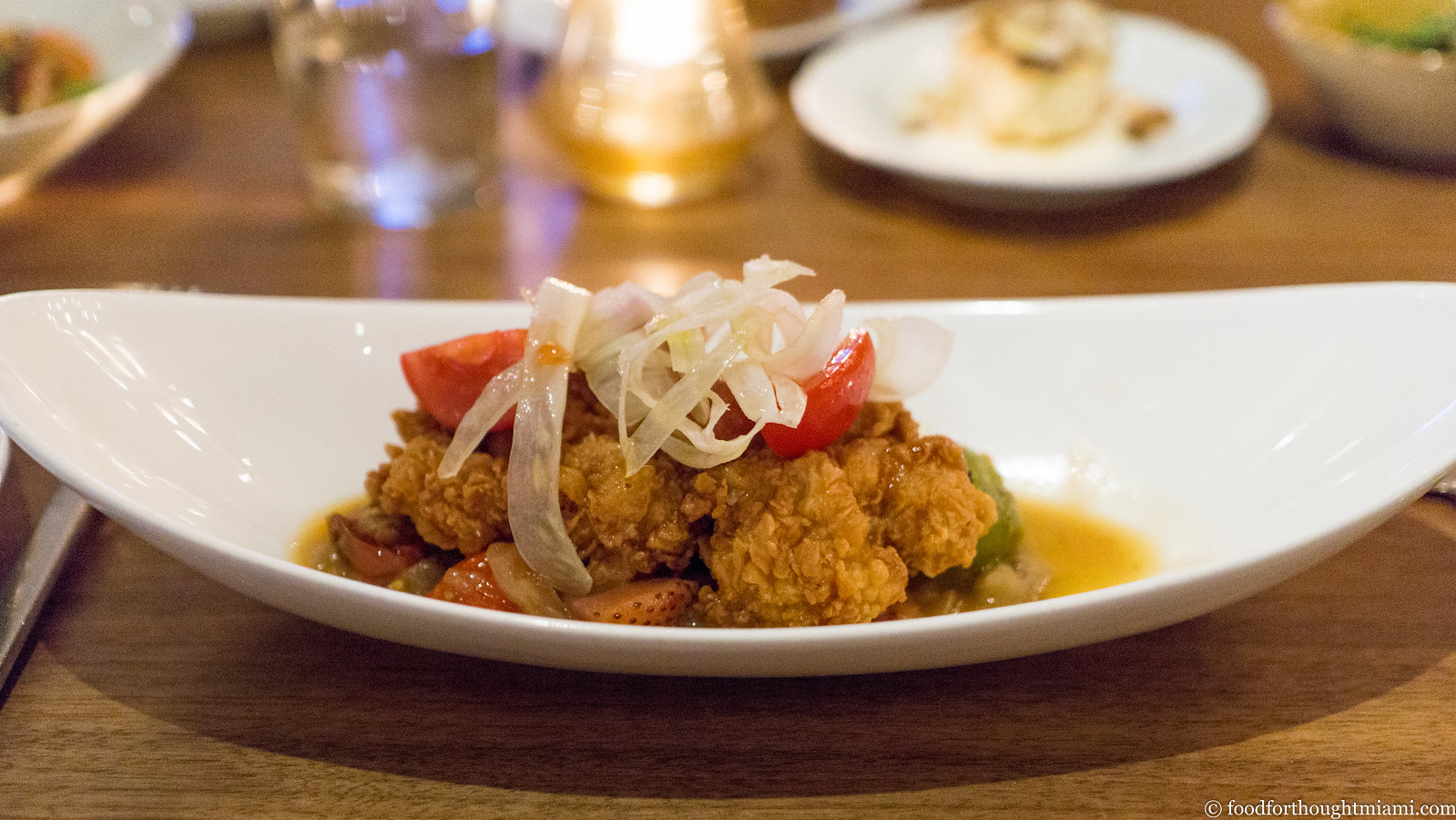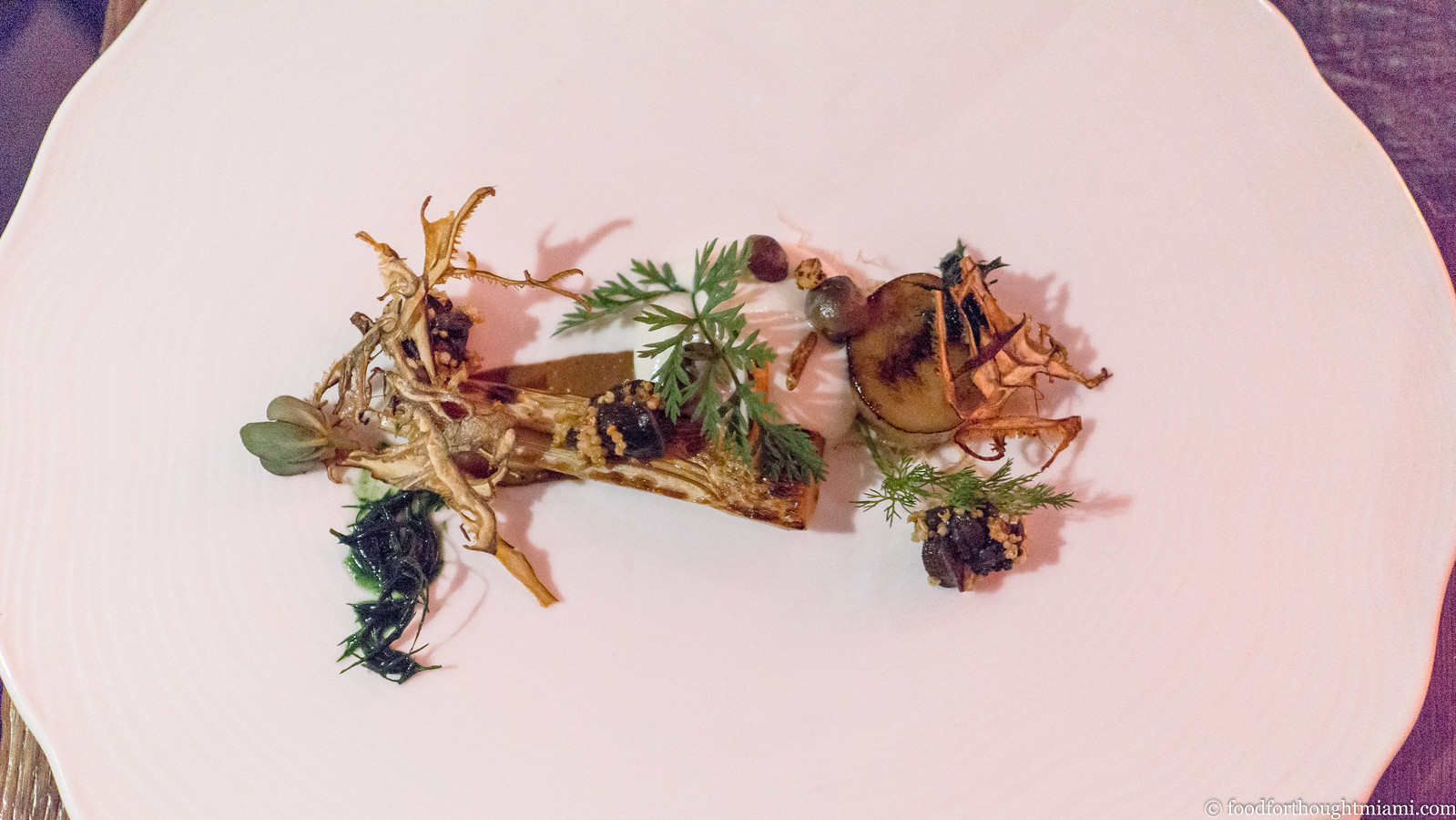 This is the first of a multi-part series of posts. Click here for Part II and for Lessons Learned in the Test Kitchen
This is the first of a multi-part series of posts. Click here for Part II and for Lessons Learned in the Test Kitchen.
“Paradigm – the Test Kitchen” is a once-a-week “restaurant within a restaurant” in Neomi’s Grill at the
Trump International Beach Resort in Sunny Isles, featuring multi-course tasting menus that explore some of the more contemporary concepts and techniques being batted about the culinary universe these days. I’ve been wanting to write about “Paradigm” since I started this blog, but had been lacking new material. I have been to a couple of
these dinners already (as well as a pre-Paradigm
birthday party dinner, which in retrospect turned out to be something of a dry run for the Paradigm format), but those were several months ago and I’d already given extensive recaps of them elsewhere.
Paradigm is an “interactive” dining experience – the chefs come out to explain several of the dishes, many involve tableside final prep (smoking guns, espuma garnishes, consommé poured at the table), and some even involve diner participation like the nuoc mom “noodles” extruded from a squirt bottle into a warm broth that we had at one dinner (modeled after Wylie Dufresne’s “instant noodles” at
wd~50). As an amateur cook and curious diner, I’m always interested in seeing and learning how the food actually gets to the plate. Give me a choice between a seat at a bustling kitchen bar where you’re at risk of being jostled by waiters picking up orders at the pass, or a plush banquette with white tablecloths, and I’ll take the kitchen bar every time. I like to see, and smell, and hear, the transformation from raw ingredients to finished dish; I also just enjoy watching the rough ballet of a well-coordinated kitchen.
Neomi's Chef de Cuisine
Chad Galiano and I tend to have the same online reading lists, and when Grant Achatz started a discussion about open kitchens and interactive dining, it prompted some thinking. The Achatz
column, and a
follow up, traced the evolution and implementation of a new idea at
Alinea, where a big silicon “plate” is unfurled over the entire table and the chefs come out of the kitchen to do the final assembly of a dish on the gigantic “plate.” My initial reaction to the Achatz piece was that it was interesting, but more akin to the traditional tableside service than it was to a genuine open kitchen (though seeing the pictures piqued my curiosity further). While it sounds like fun, I’m not sure that it’s what some diners – myself at least – seek in the “open kitchen” experience. It may not be true of everyone – and it may defuse some of the “mystery” of the textural and other transformations that are among the hallmarks of much contemporary cooking – but some of us actually want to see the whole process, and see the kitchen actually at work instead of putting on a show.
We traded some emails, which led to the following proposal from Executive Chef Kurtis Jantz and Chef Chad: come in for a Paradigm dinner, but there would be no seat at the table for me. Instead, I would join them in the kitchen, watch (and possibly “help”) as dishes were being prepared, and they’d make an extra plate of each dish for me and I could eat it standing up in the kitchen. As an extra bonus, Chef Christopher Windus of
BlueZoo in Orlando would be in as collaborating guest chef. Now
this would be an interactive dining experience. Needless to say, this was an offer I accepted eagerly.
After spending 6+ hours in the Neomi’s Grill kitchen for a Paradigm dinner service this past Friday, I have much to tell. First off, let me again express my gratitude to Chefs K, Chad and Chris, as well as the entire staff at Neomi’s, for putting up with me as I got to experience my “chef’s fantasy camp.” Everyone was tremendously friendly and accommodating. I’ve been kicking around how best to share the experience, and eventually arrived at a multi-part approach; a “running diary” a la Bill Simmons’
NBA draft diaries, and then perhaps a list of “lessons learned.”
A complete set of my pictures from the evening can be found
here on flickr.
5:30 pm – I get to the restaurant, ask for Chef Chad, and he comes out and brings me around back into the kitchen for a quick tour and introductions. The kitchen is a bit of a maze and I’m thinking I should be leaving a trail of bread crumbs. Chad introduces me to the rest of the folks – Pablo working sauté, Moe working pantry, Kenold working the grill, Marianne working everywhere. Pastry Chef Fabian di Paolo pops in and out. The kitchen is about 15 degrees warmer than the restaurant, and I almost immediately break into a sweat. This is one of my great talents - Mrs. F calls me "alpaca" because I'm a heavy sweater. Howie Kleinberg's got nothing on me.
5:33 pm – a look at tonight’s menu. Eleven courses total (a little more elaborate even than the typical Paradigm dinner). Chefs K, Chad and Chris have been brainstorming on the menu for most of the past week. There are handwritten notes here and there and drawings for what plates will be used for each course. I’ve had these meals before but never really thought about the logistics in any great detail. They are confounding. Eleven courses, each of which has on average about five components, makes for more than 50 moving pieces. Wow.
5:34 pm – Chef K is in his office (I’ve seen bigger broom closets) with one of the assistant chefs, Osnel. Chef K is going on vacation for a few days and is debriefing on everything that will need to happen in his absence.
5:36 pm – Chef Mike (
nice to see him back in the kitchen) brings me a chef’s jacket and apron to wear. OK, I’ll admit it. I feel pretty cool wearing a chef’s jacket. I’m like a kid at
Wannadoo City. And, yes, I'm a dork.
5:38 pm – Chef Chad is ready to put me to work. At a station he’s set up a squeeze bottle filled with Emmental cheese thinned down with milk to a loose fondue consistency, a couple bowls filled with what looks like water, a tablespoon, and a spoon that looks like a metal Chinese soup spoon but slotted, with holes in the bottom. I’ve got an idea of what’s coming – spherification! One of the bowls has had some sodium alginate (a product derived from seaweed) added, producing a reaction with the calcium in the cheese (a little extra is added) so that when a blob of the cheese goes into the alginate solution it forms a firmer skin or membrane around the outside, but remains liquid in the center. Presto – a liquid-filled cheese orb! And no sharp objects involved.

5:39 pm – Chef Chad shows me the technique of squeezing some of the cheese into a tablespoon filled with the alginate solution, then unloading into the bowl, then, after a short time to let the membrane form, scooping it with the slotted spoon into the second water bowl to hold for service. And away we go – I’m spherifying! Actually reverse spherifying, if we want to be precise (“normal” spherification adds the sodium alginate to the flavored liquid, then puts it into a calcium chloride bath; “reverse” spherification has the calcium in the liquid and uses a sodium alginate bath). I announce to noone in particular that I am going to add “molecular gastronomer” to my business card.
5:42 pm – Chef Chad introduces me to Chef Chris Windus from BlueZoo. If Chef Chris weren’t wearing chef’s whites, I would have guessed that he was an NFL linebacker. He’s got a smirk on his face that seems to say, “Who let this joker into the kitchen?” Over the course of the evening, I’m somewhat relieved to see that this may just be an expression of perpetual bemusement. Or maybe I’m letting myself off too easy.
5:54 pm – I’m still spherifying. I can only do a few of these at a time as they seem to want to stick together. And I’m nervous. Whenever I’ve seen spheres, they’ve always looked so perfectly round. Mine? Not so much. Chef Chad comes by and looks at one, kindly says “It looks like a heart.” OK, not really what we’re shooting for but still it’s cute, right? But to me it just looks like it’s got a butt crack. I’m hoping these smooth out some as they soak.

6:00 pm – I’ve got about 30-some-odd Emmental cheese spheres done now. There’s only 10 diners and only one of these is going on each plate for a particular dish, but I want to give them a high margin for error. Besides, it’s fun.
6:23 pm – Jacob Katel from
New Times shows up. His food porn on
Short Order often makes me drool. I’m astonished to see the tiny little camera he uses for his work.
6:30 pm – feels like the calm before the storm. Marianne is working on a pistachio brittle for one of the dishes. Marie, who usually works banquet garde manger, comes in and starts helping out. I later find out she's doing this off the clock just to learn. She also gives me the “Who let this joker into the kitchen?” look.
6:36 pm – maybe for some, being an Executive Chef is all just glory, appearances at food festivals and guest judging on
Top Chef. If you read Eric Ripert’s “
On the Line,” for instance, you don’t get the impression he’s actually stepping behind the line and cooking all that often any more. But there’s Chef K, chopping onions. Maybe he’s just putting on a show for me.
6:42 pm – so much of this meal is planned, and indeed many components are prepared well in advance of service, and yet you always have to be ready to improvise. Chef K is unhappy with how the batter for some onion rings is setting up. It worked fine yesterday, but today it’s just soaking up oil; has me try one – it’s greasy. Going to try adding more flour but may just start from scratch.

6:47 pm – I notice that Chef Chris has been wheeling around the
Anti-Griddle (it’s like a griddle but with cold instead of heat, so that you can quickly freeze liquids on its surface) brought down with him from Orlando and plugging it into different outlets. About 30 seconds after he flips the power switch, it makes a sputtering sound. That’s not good.
6:53 pm – Chef Chad brings me one of Chef Chris’ liquid corn ravioli to try – straight out of a buttery sauté pan. It is fantastic. The pasta texture is silky but still has some substance to it, and the corn filling is oozy, salty, sweet and bursting with fresh corn flavor. One bite and I know where I’m eating next time I’m in Orlando.
6:58 pm – Chef Chris is still hauling the Anti-Griddle from outlet to outlet, trying to find one that will make it happy. So far, no such luck.

7:04 pm – Chef Chad invites me to help with assembly of the first course, the “raza’ chowda.” This dish has all the components of a clam chowder, but they’re going to be assembled in a hollow glass tube; you slurp on one end, and get all the contents in your mouth at once. Diced razor clams, tiny mirepoix dice, and a gelatinized smoked tomato water have already been assembled in the tubes. I think five of us (Chris, Kurtis, Chad, Jacob and myself) crowd into the little walk-in cooler to help set these up, or to take pix. A little “cork” of potato is stamped out for one end of the tube from planks of potato cooked sous-vide at 83C. At the table, the chefs will add a bacon foam to the tube to complete the chowder flavors. I get one to try – the flavors are spot-on and the delivery method is really clever. You first get each component one-by-one, and then as you get all of them, the flavor combination perfectly duplicates a clam chowder.
7:08 pm – Steven, the food and beverage manager, comes into the kitchen to let everyone know the Paradigm guests have started to arrive. Someone who had been to an earlier Paradigm dinner bought out the whole table for tonight. They’re also expecting Malka Espinel, Pastry Chef at
Johnny V in Fort Lauderdale, to be paying a visit later tonight.
7:11 pm – Chef Chris breaks out a Level Vodka bottle that is filled with a neon-pink liquid. What is this? Bubble-Yum bubble-gum infused vodka. Pours a sample for us. Lord – keep this away from my children. It tastes just like bubble gum. Unreal. For good measure, we also try a sample of the Wild Turkey American Honey bourbon. Yes, this could be dangerous stuff.
7:16 pm – Chef Chris is still moving his Anti-Griddle from outlet to outlet, but everyone is quickly sizing up Plan B. The Anti-Griddle was going to be used to make a frozen blood orange disk for a “refresh” intermezzo course; Chef K finds a silicon hemispheric mold sheet which he cuts in half and puts in a tray of ice with some kosher salt. The blood orange puree will be scooped into the molds, laid over the ice, and then put into the freezer to set up.
7:21 pm – several things are taken out of the walk-in to come to temperature, including Shropshire blue cheese “cheesecakes” for course II. I get to sample one – fluffy cheesecake texture, vivid blue cheese flavor. This is going to get paired with a riff on buffalo wings. I think it’s going to work.
7:32 pm - Steven advises that the guests have sat down for dinner. The show is on. Meanwhile, the kitchen hums with the constant background sounds of room service and dining room orders going out. While I came for Paradigm, there’s still a hotel to feed.
7:35 pm – the chefs go out to the table to meet-n-greet and do the tableside presentation for the “raza’ chowda’” in a tube.

7:37 pm – Chef Chad is starting the plating for the second dish, “food party episode 1”. He
explains the inspiration much better than I’ll be able to do. Sounds like
Pee-Wee’s Playhouse meets
Tim & Eric Awesome Show meets
Iron Chef. I think I need to watch this. There is one long table in the very front of the kitchen that is used for all the assembly and plating. Chef Chad starts by making circular patterns of carrot and celery on each of the plates. These are followed by the blue cheese-cake, then a chicken “wing” lollipop (actually thigh meat molded together using
Activa a/k/a transglutaminase a/k/a “meat glue”) with a semi-crispy, hot-sauce infused batter, some julienned pickled carrots over the cheesecake, and finally, a hot sauce froth.
7:45 pm – servers return from the table after the tubular chowder experience. Some of the diners are a little squeamish about it, but after trying, they all seem to enjoy it.
7:57 pm – “food party episode 1” goes out the door to the table. I sample one in the kitchen. In prior experiences I’ve been underwhelmed by dishes using “meat glue,” but this chicken lollipop sells me on its virtues. The shredded thigh meat has the intense flavor of dark meat, is incredibly juicy, and has not been so pulverized as to be unrecognizable as chicken. I’d initially thought the hot sauce flavor was coming just from the sauce, but it’s in the batter too. The rest of the flavors are spot on. I especially like the vividness of the carrot and celery drizzles on the plate. They may look pretty, but they're not just decoration.

8:03 pm – Chef Chris drops back to the sauté line to warm his liquid corn ravioli.

8:10 pm – plating starts for course III, liquid corn ravioli over a bed of corn and spaghetti squash, with a thin, square sheet of
Laughing Bird shrimp (another Activa trick). I’m invited to help with plating the shrimp sheets. They’re each already individually portioned between squares of wax paper, and just require a little flip onto the plate. Most of mine comply with only minor mangling. Fortunately, Marie notices that the squares are each also covered with a transparent sheet of acetate, and we remove it before service.
8:14 pm – ravioli are out the door. I try the fully composed dish. The ravioli is just as delicious as the one I sampled earlier (though it was more fun to pop a whole one in my mouth straight from the pan); the corn and spaghetti squash hash it’s served over adds another nice sweet vegetable component. The Laughing Bird shrimp used for the sheet, with a little bit of chive in the mix, are absolutely delicious; I’m torn as to whether the presentation and textural transformation really add anything, but polish off the dish before I can decide.

8:18 pm – course IV, “hogs headless cheese” sandwiches, are getting assembled. A clamshell-shaped steamed brioche bun (similar to the ones traditionally served with Peking duck) is topped with a slice of “hogs headless cheese” – so-called because it’s a pork “head cheese” made with trotters and shoulder but no head – then paired with a rhubarb sriracha (made in house, with a nice acidic tang from the rhubarb but needing of more heat, in my opinion, if it is to call itself a sriracha sauce), julienned pickled green peaches, and a garlic scape mayo.

8:25 pm – headless cheese sandwiches go out to the table and I get to sample one. The components are mostly Southern, and yet the flavor composition reflects a distinctly Asian profile. In fact, this is clearly a banh mi with a Southern accent. The head cheese might have been a little too bland on its own and each of the other components a little too assertive, but together – fantastic. They've made an extra of each dish for Jason from New Times too. I've got a sense he's never seen food like this before, but in addition to being a good photographer, the guy's a good sport and a good eater too. He puts away everything with glee.

8:42 pm – each Paradigm menu I’ve seen has a “refresh” course in the middle – a variation on the old-school tradition of an “intermezzo,” often a sorbet, to serve as a “palate cleanser.” This time around, they go old-school with the sorbet, but new school with the flavors. Deborah, Fabian's assistant pastry chef, makes an appearance. A small bamboo serving dish gets a bit of kumquat marmalade, and little globes of the blood orange sorbet (the Plan B as a result of the non-functioning anti-griddle) and a piquillo pepper sorbet studded with black caraway seeds. These go out to the table with a pair of little chopsticks. With the extra one made for me in the kitchen, I opt to just pick up the little dish and do the whole thing like a shot. I think this is the way to go. The flavors play off each other beautifully, doing a great balancing act between savory and sweet.
Coming up next ... six more courses - and do my Emmental orbs pass the test?
Neomi's
Trump International Beach Resort
18001 Collins Avenue
Sunny Isles Beach, FL
305.692.5604






